Report on Accounting For Leases
VerifiedAdded on 2022/08/27
|14
|3698
|25
AI Summary
Contribute Materials
Your contribution can guide someone’s learning journey. Share your
documents today.
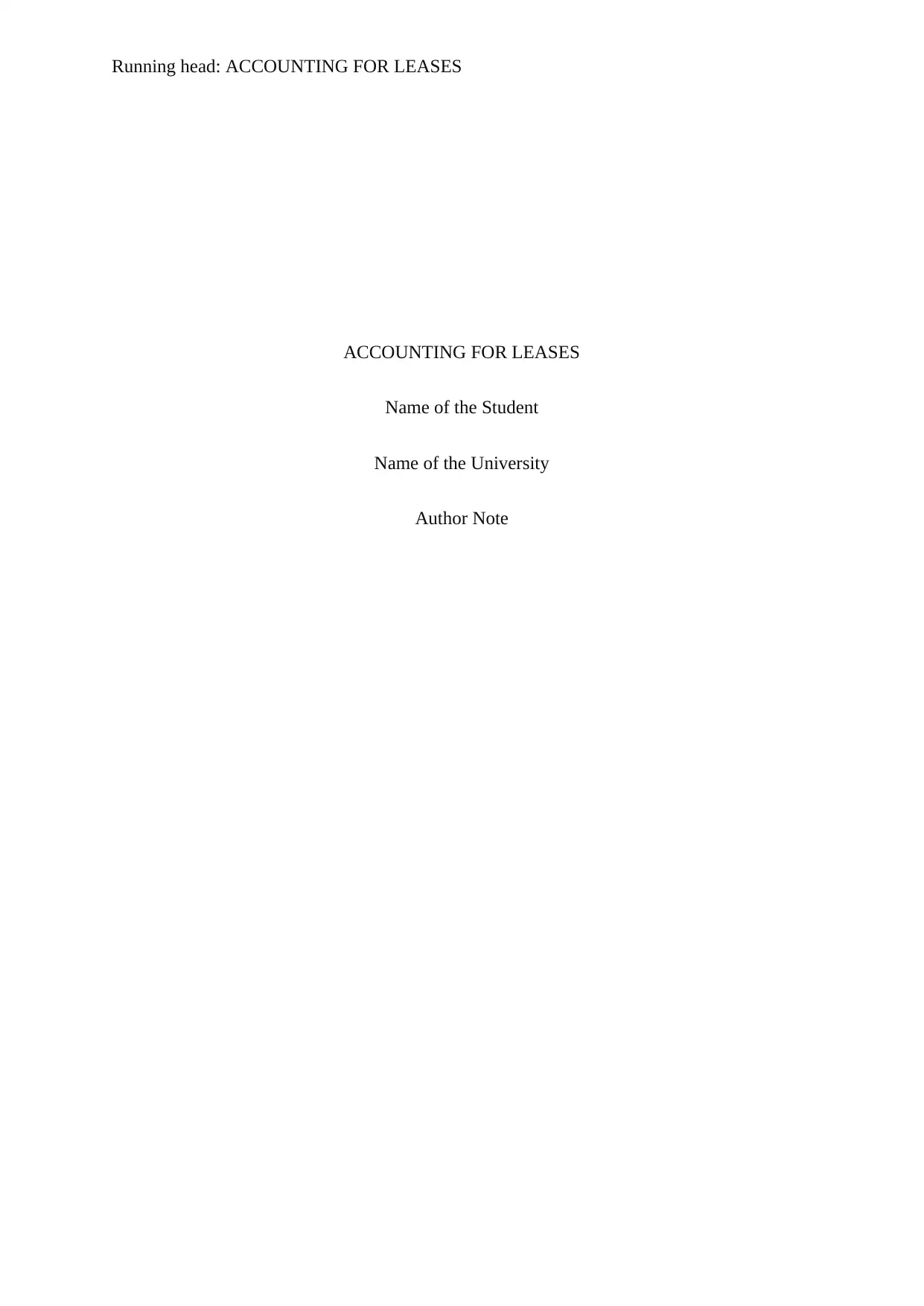
Running head: ACCOUNTING FOR LEASES
ACCOUNTING FOR LEASES
Name of the Student
Name of the University
Author Note
ACCOUNTING FOR LEASES
Name of the Student
Name of the University
Author Note
Secure Best Marks with AI Grader
Need help grading? Try our AI Grader for instant feedback on your assignments.

1ACCOUNTING FOR LEASES
Executive summary
The aim of this report is to analyse the impact of the accounting for leases on the finacuila
statements of the organisatuons. The report contains a review of the literature of three articles
from which it can be possible to evaluate the effects of the lease accounting process and how
the organisations has implemented the AASB 16 rules and what benefits such rules can bring
in manging the lease agreements.
Executive summary
The aim of this report is to analyse the impact of the accounting for leases on the finacuila
statements of the organisatuons. The report contains a review of the literature of three articles
from which it can be possible to evaluate the effects of the lease accounting process and how
the organisations has implemented the AASB 16 rules and what benefits such rules can bring
in manging the lease agreements.
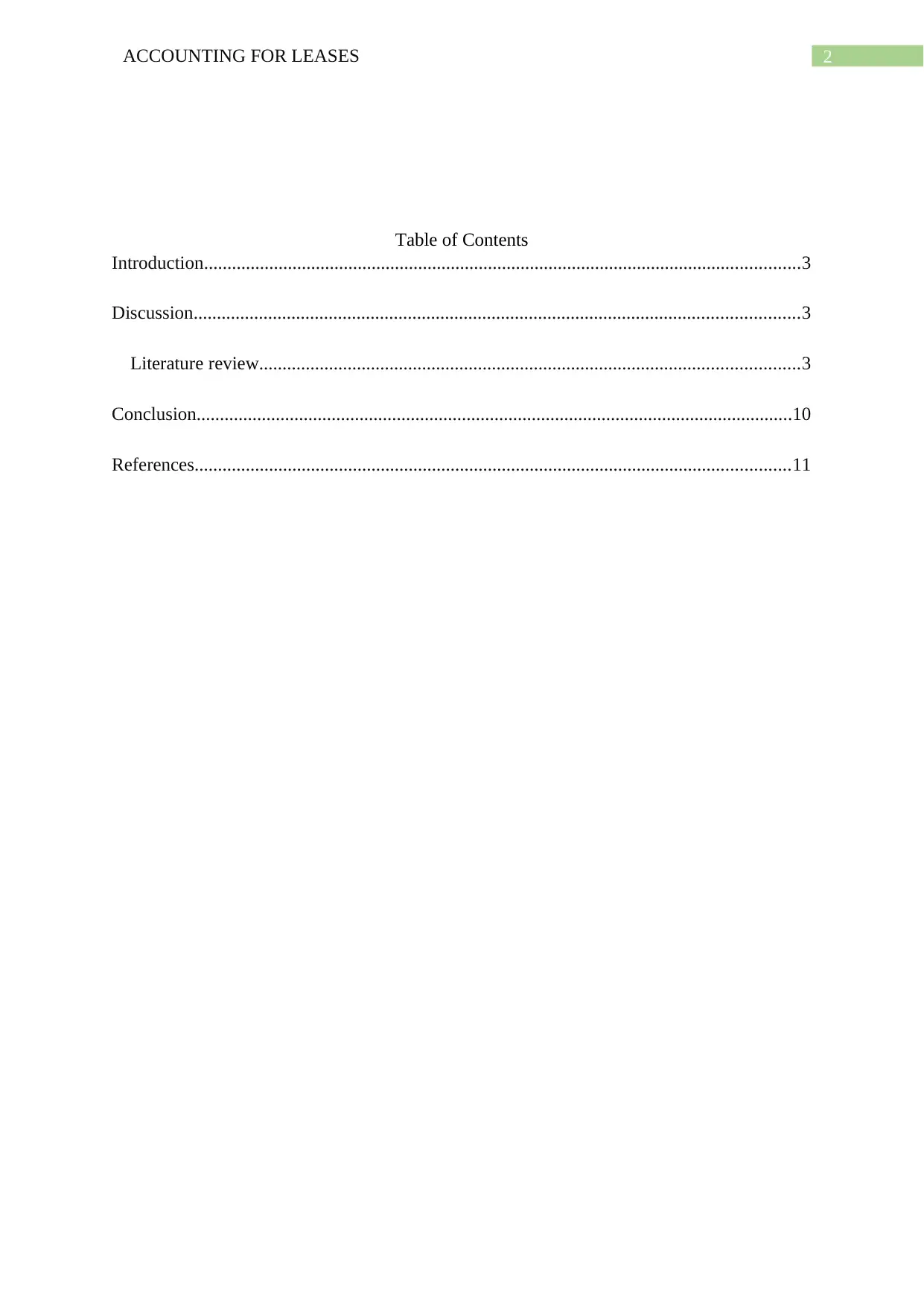
2ACCOUNTING FOR LEASES
Table of Contents
Introduction................................................................................................................................3
Discussion..................................................................................................................................3
Literature review....................................................................................................................3
Conclusion................................................................................................................................10
References................................................................................................................................11
Table of Contents
Introduction................................................................................................................................3
Discussion..................................................................................................................................3
Literature review....................................................................................................................3
Conclusion................................................................................................................................10
References................................................................................................................................11
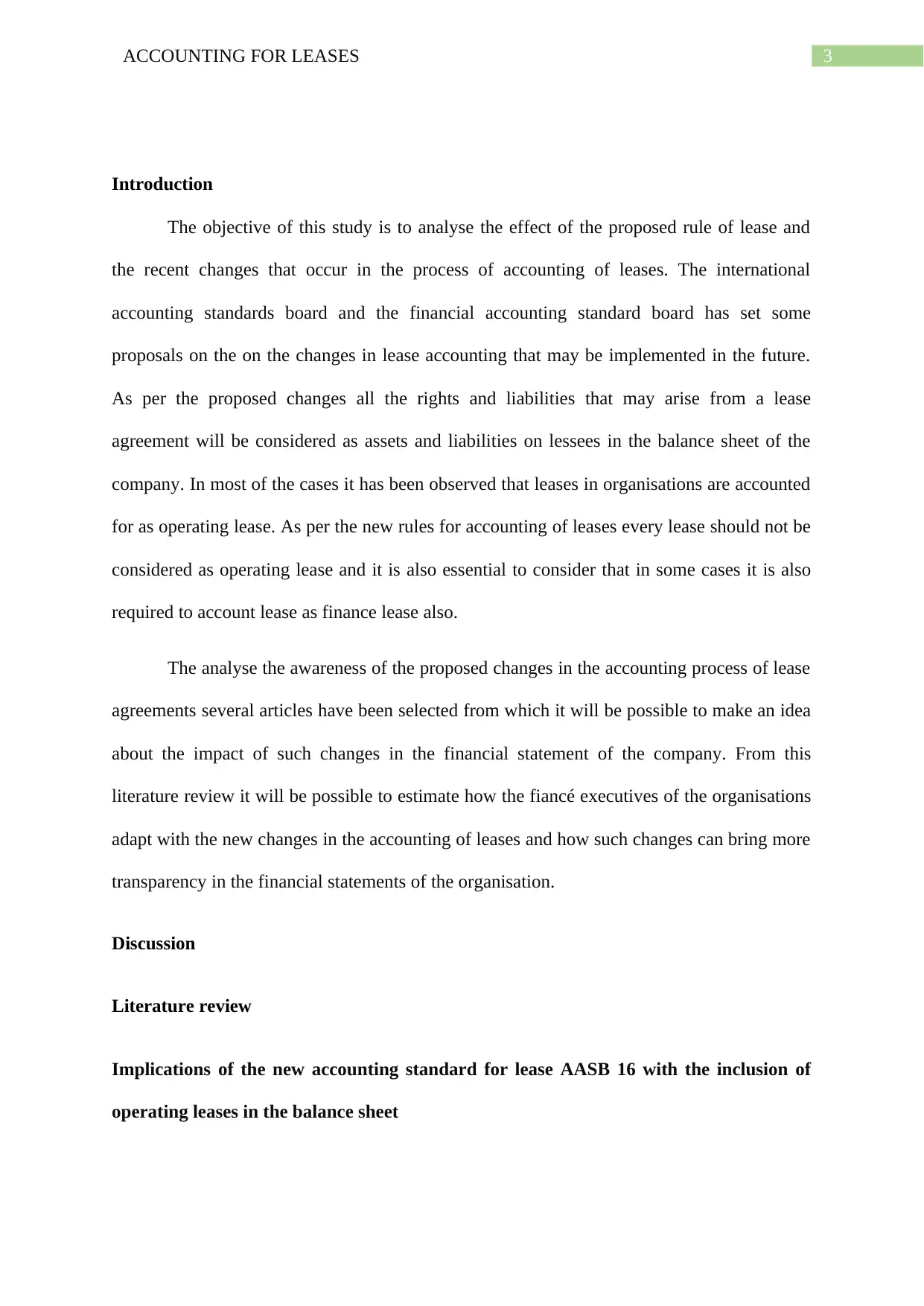
3ACCOUNTING FOR LEASES
Introduction
The objective of this study is to analyse the effect of the proposed rule of lease and
the recent changes that occur in the process of accounting of leases. The international
accounting standards board and the financial accounting standard board has set some
proposals on the on the changes in lease accounting that may be implemented in the future.
As per the proposed changes all the rights and liabilities that may arise from a lease
agreement will be considered as assets and liabilities on lessees in the balance sheet of the
company. In most of the cases it has been observed that leases in organisations are accounted
for as operating lease. As per the new rules for accounting of leases every lease should not be
considered as operating lease and it is also essential to consider that in some cases it is also
required to account lease as finance lease also.
The analyse the awareness of the proposed changes in the accounting process of lease
agreements several articles have been selected from which it will be possible to make an idea
about the impact of such changes in the financial statement of the company. From this
literature review it will be possible to estimate how the fiancé executives of the organisations
adapt with the new changes in the accounting of leases and how such changes can bring more
transparency in the financial statements of the organisation.
Discussion
Literature review
Implications of the new accounting standard for lease AASB 16 with the inclusion of
operating leases in the balance sheet
Introduction
The objective of this study is to analyse the effect of the proposed rule of lease and
the recent changes that occur in the process of accounting of leases. The international
accounting standards board and the financial accounting standard board has set some
proposals on the on the changes in lease accounting that may be implemented in the future.
As per the proposed changes all the rights and liabilities that may arise from a lease
agreement will be considered as assets and liabilities on lessees in the balance sheet of the
company. In most of the cases it has been observed that leases in organisations are accounted
for as operating lease. As per the new rules for accounting of leases every lease should not be
considered as operating lease and it is also essential to consider that in some cases it is also
required to account lease as finance lease also.
The analyse the awareness of the proposed changes in the accounting process of lease
agreements several articles have been selected from which it will be possible to make an idea
about the impact of such changes in the financial statement of the company. From this
literature review it will be possible to estimate how the fiancé executives of the organisations
adapt with the new changes in the accounting of leases and how such changes can bring more
transparency in the financial statements of the organisation.
Discussion
Literature review
Implications of the new accounting standard for lease AASB 16 with the inclusion of
operating leases in the balance sheet
Secure Best Marks with AI Grader
Need help grading? Try our AI Grader for instant feedback on your assignments.

4ACCOUNTING FOR LEASES
The main objective of this article is to highlight how the new accounting standard for
AASB 16 will create an impact on the financial records of the companies and the effect of
inclusion of operating leases in the balance sheet. The article provided that due to the
inclusion of the operating lease in the balance sheet some of the important financial ratios
may be affected particularly the return on assets and the debt to equity ratio. From the
research it has been observed that the inclusion of the operating lease does not affect the key
ratios that much as it has been expected. The results reflect that the changes effect only 10%
of the material value of the assets and the liabilities which is under the threshold limit of the
accounting standard 1031 of materiality (Birt et al 2020).
The impact of the accounting for leases also affects the normal process of accounting
that has been practiced by the accountants of the organisation. Due to the changes the
accountants have to revalue the assets and liabilities as per the new standards which is time
consuming and complex in nature. The key elements of the article is that it eliminates the
distinction between the financial and operating leases distinction and suggests that all the
leases are to be represented in the balance sheet of the lessee by a combination of assets and
liabilities. The justification of this process is very fair and simple and it has the same basic
concept as stated in the provisions of the generally accepted accounting principle and the
international financial reporting system. In spite of the fact that there are many provisions and
complexities in the lease arrangements, the AASB 16 and the provisions of IFRS views that
the economic impact of lease on the financial position of an organisation is same
(SECINARO et al 2017). Particularly the author highlighted that the right of a lessee to use a
property which has been taken ion lease fulfils all the requirements that defines an assets,
which means that leased property should be accounted as an asset. On the contrary the
obligation of a lessee should be recorded as a liability as it meet all the requirements that
indicates that the rental payments on lease is similar to that of any other liabilities. The
The main objective of this article is to highlight how the new accounting standard for
AASB 16 will create an impact on the financial records of the companies and the effect of
inclusion of operating leases in the balance sheet. The article provided that due to the
inclusion of the operating lease in the balance sheet some of the important financial ratios
may be affected particularly the return on assets and the debt to equity ratio. From the
research it has been observed that the inclusion of the operating lease does not affect the key
ratios that much as it has been expected. The results reflect that the changes effect only 10%
of the material value of the assets and the liabilities which is under the threshold limit of the
accounting standard 1031 of materiality (Birt et al 2020).
The impact of the accounting for leases also affects the normal process of accounting
that has been practiced by the accountants of the organisation. Due to the changes the
accountants have to revalue the assets and liabilities as per the new standards which is time
consuming and complex in nature. The key elements of the article is that it eliminates the
distinction between the financial and operating leases distinction and suggests that all the
leases are to be represented in the balance sheet of the lessee by a combination of assets and
liabilities. The justification of this process is very fair and simple and it has the same basic
concept as stated in the provisions of the generally accepted accounting principle and the
international financial reporting system. In spite of the fact that there are many provisions and
complexities in the lease arrangements, the AASB 16 and the provisions of IFRS views that
the economic impact of lease on the financial position of an organisation is same
(SECINARO et al 2017). Particularly the author highlighted that the right of a lessee to use a
property which has been taken ion lease fulfils all the requirements that defines an assets,
which means that leased property should be accounted as an asset. On the contrary the
obligation of a lessee should be recorded as a liability as it meet all the requirements that
indicates that the rental payments on lease is similar to that of any other liabilities. The
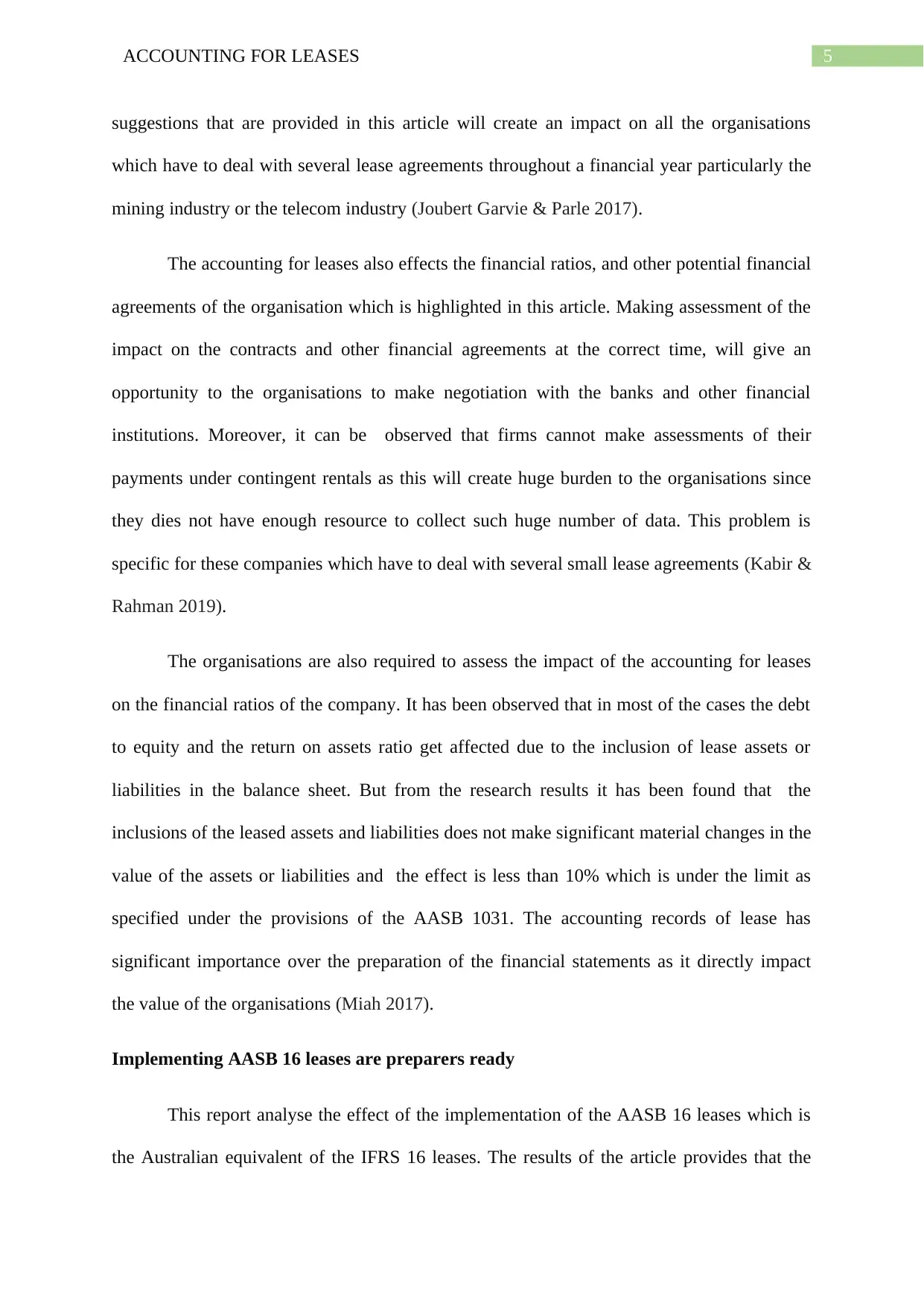
5ACCOUNTING FOR LEASES
suggestions that are provided in this article will create an impact on all the organisations
which have to deal with several lease agreements throughout a financial year particularly the
mining industry or the telecom industry (Joubert Garvie & Parle 2017).
The accounting for leases also effects the financial ratios, and other potential financial
agreements of the organisation which is highlighted in this article. Making assessment of the
impact on the contracts and other financial agreements at the correct time, will give an
opportunity to the organisations to make negotiation with the banks and other financial
institutions. Moreover, it can be observed that firms cannot make assessments of their
payments under contingent rentals as this will create huge burden to the organisations since
they dies not have enough resource to collect such huge number of data. This problem is
specific for these companies which have to deal with several small lease agreements (Kabir &
Rahman 2019).
The organisations are also required to assess the impact of the accounting for leases
on the financial ratios of the company. It has been observed that in most of the cases the debt
to equity and the return on assets ratio get affected due to the inclusion of lease assets or
liabilities in the balance sheet. But from the research results it has been found that the
inclusions of the leased assets and liabilities does not make significant material changes in the
value of the assets or liabilities and the effect is less than 10% which is under the limit as
specified under the provisions of the AASB 1031. The accounting records of lease has
significant importance over the preparation of the financial statements as it directly impact
the value of the organisations (Miah 2017).
Implementing AASB 16 leases are preparers ready
This report analyse the effect of the implementation of the AASB 16 leases which is
the Australian equivalent of the IFRS 16 leases. The results of the article provides that the
suggestions that are provided in this article will create an impact on all the organisations
which have to deal with several lease agreements throughout a financial year particularly the
mining industry or the telecom industry (Joubert Garvie & Parle 2017).
The accounting for leases also effects the financial ratios, and other potential financial
agreements of the organisation which is highlighted in this article. Making assessment of the
impact on the contracts and other financial agreements at the correct time, will give an
opportunity to the organisations to make negotiation with the banks and other financial
institutions. Moreover, it can be observed that firms cannot make assessments of their
payments under contingent rentals as this will create huge burden to the organisations since
they dies not have enough resource to collect such huge number of data. This problem is
specific for these companies which have to deal with several small lease agreements (Kabir &
Rahman 2019).
The organisations are also required to assess the impact of the accounting for leases
on the financial ratios of the company. It has been observed that in most of the cases the debt
to equity and the return on assets ratio get affected due to the inclusion of lease assets or
liabilities in the balance sheet. But from the research results it has been found that the
inclusions of the leased assets and liabilities does not make significant material changes in the
value of the assets or liabilities and the effect is less than 10% which is under the limit as
specified under the provisions of the AASB 1031. The accounting records of lease has
significant importance over the preparation of the financial statements as it directly impact
the value of the organisations (Miah 2017).
Implementing AASB 16 leases are preparers ready
This report analyse the effect of the implementation of the AASB 16 leases which is
the Australian equivalent of the IFRS 16 leases. The results of the article provides that the
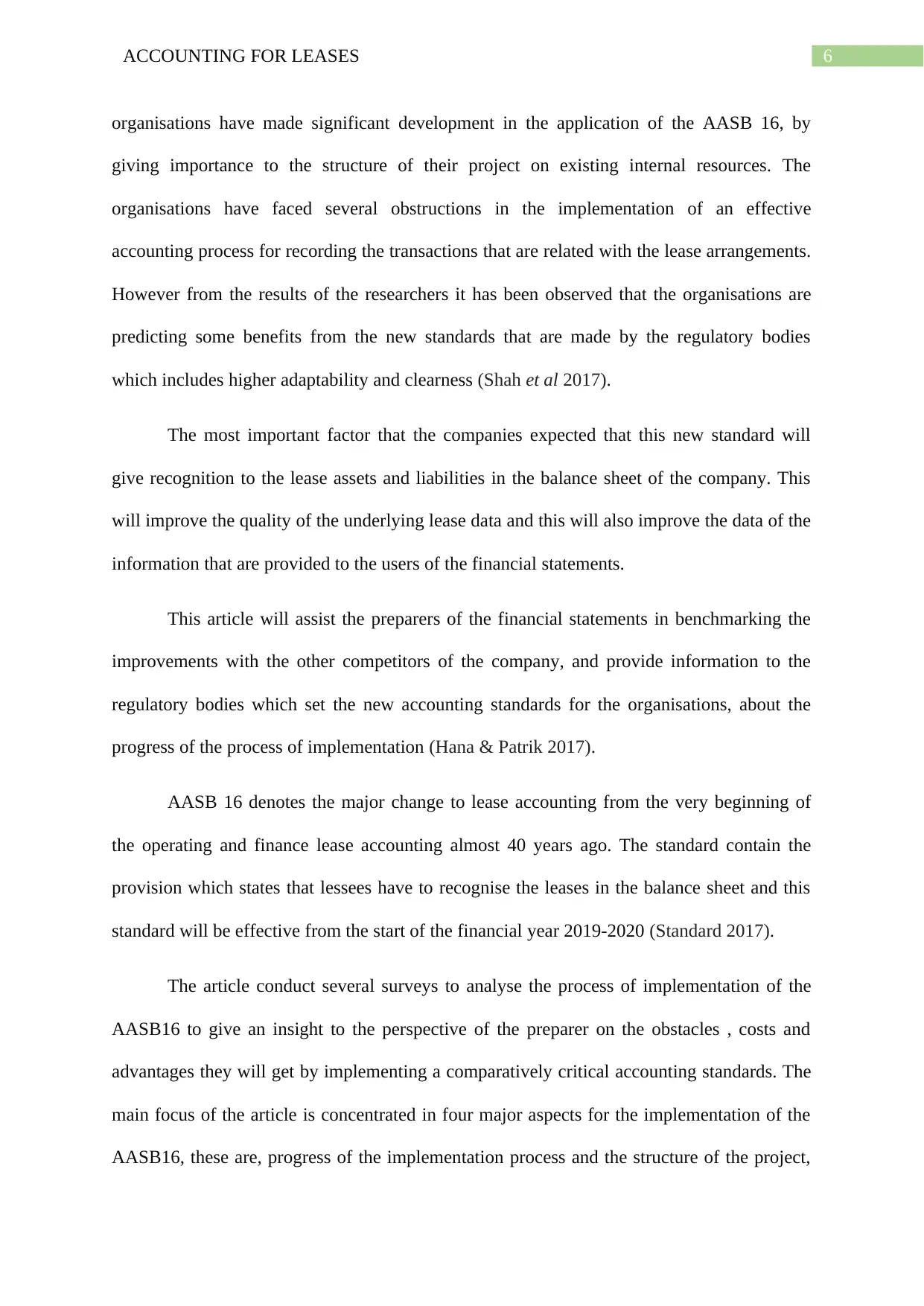
6ACCOUNTING FOR LEASES
organisations have made significant development in the application of the AASB 16, by
giving importance to the structure of their project on existing internal resources. The
organisations have faced several obstructions in the implementation of an effective
accounting process for recording the transactions that are related with the lease arrangements.
However from the results of the researchers it has been observed that the organisations are
predicting some benefits from the new standards that are made by the regulatory bodies
which includes higher adaptability and clearness (Shah et al 2017).
The most important factor that the companies expected that this new standard will
give recognition to the lease assets and liabilities in the balance sheet of the company. This
will improve the quality of the underlying lease data and this will also improve the data of the
information that are provided to the users of the financial statements.
This article will assist the preparers of the financial statements in benchmarking the
improvements with the other competitors of the company, and provide information to the
regulatory bodies which set the new accounting standards for the organisations, about the
progress of the process of implementation (Hana & Patrik 2017).
AASB 16 denotes the major change to lease accounting from the very beginning of
the operating and finance lease accounting almost 40 years ago. The standard contain the
provision which states that lessees have to recognise the leases in the balance sheet and this
standard will be effective from the start of the financial year 2019-2020 (Standard 2017).
The article conduct several surveys to analyse the process of implementation of the
AASB16 to give an insight to the perspective of the preparer on the obstacles , costs and
advantages they will get by implementing a comparatively critical accounting standards. The
main focus of the article is concentrated in four major aspects for the implementation of the
AASB16, these are, progress of the implementation process and the structure of the project,
organisations have made significant development in the application of the AASB 16, by
giving importance to the structure of their project on existing internal resources. The
organisations have faced several obstructions in the implementation of an effective
accounting process for recording the transactions that are related with the lease arrangements.
However from the results of the researchers it has been observed that the organisations are
predicting some benefits from the new standards that are made by the regulatory bodies
which includes higher adaptability and clearness (Shah et al 2017).
The most important factor that the companies expected that this new standard will
give recognition to the lease assets and liabilities in the balance sheet of the company. This
will improve the quality of the underlying lease data and this will also improve the data of the
information that are provided to the users of the financial statements.
This article will assist the preparers of the financial statements in benchmarking the
improvements with the other competitors of the company, and provide information to the
regulatory bodies which set the new accounting standards for the organisations, about the
progress of the process of implementation (Hana & Patrik 2017).
AASB 16 denotes the major change to lease accounting from the very beginning of
the operating and finance lease accounting almost 40 years ago. The standard contain the
provision which states that lessees have to recognise the leases in the balance sheet and this
standard will be effective from the start of the financial year 2019-2020 (Standard 2017).
The article conduct several surveys to analyse the process of implementation of the
AASB16 to give an insight to the perspective of the preparer on the obstacles , costs and
advantages they will get by implementing a comparatively critical accounting standards. The
main focus of the article is concentrated in four major aspects for the implementation of the
AASB16, these are, progress of the implementation process and the structure of the project,
Paraphrase This Document
Need a fresh take? Get an instant paraphrase of this document with our AI Paraphraser
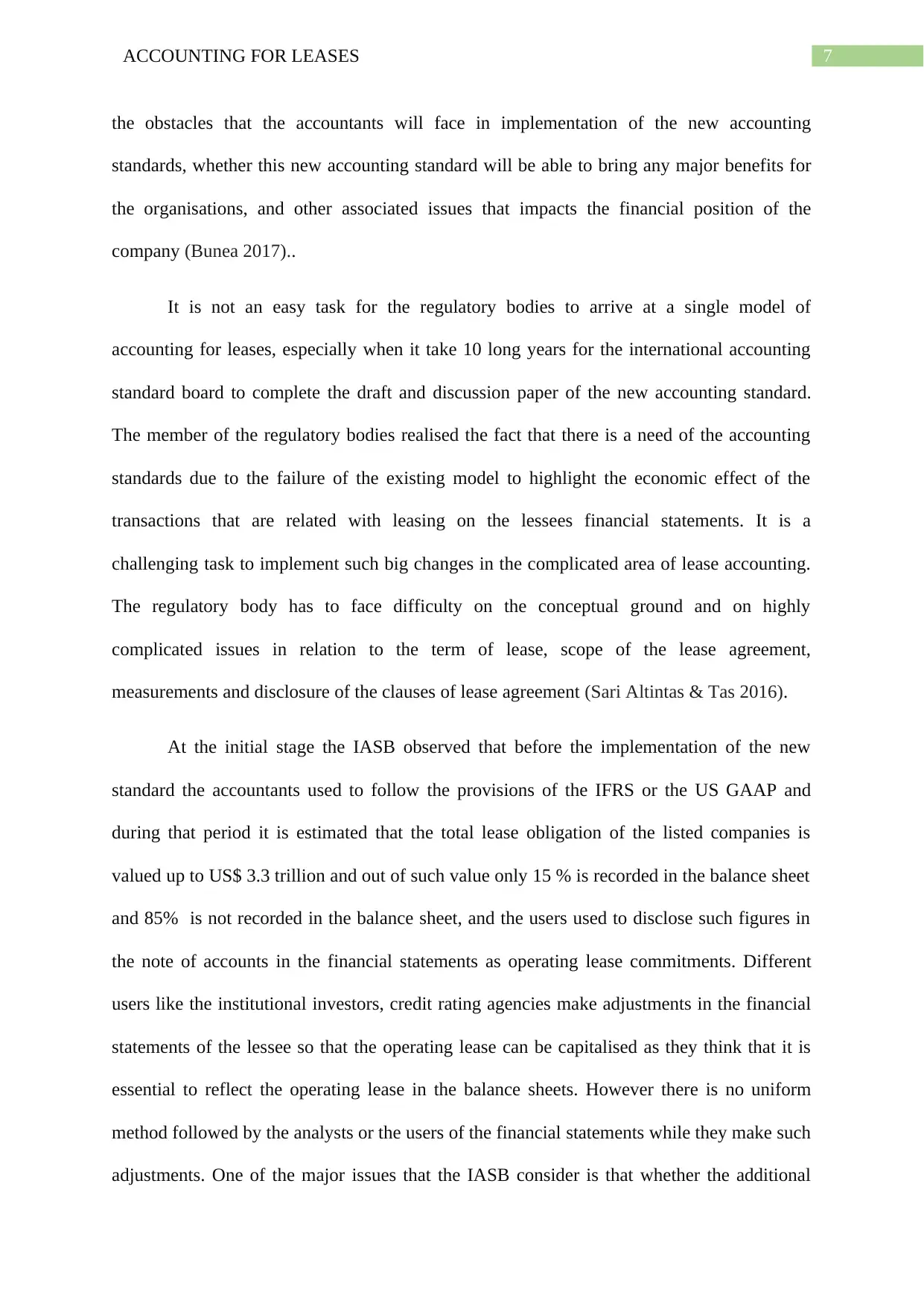
7ACCOUNTING FOR LEASES
the obstacles that the accountants will face in implementation of the new accounting
standards, whether this new accounting standard will be able to bring any major benefits for
the organisations, and other associated issues that impacts the financial position of the
company (Bunea 2017)..
It is not an easy task for the regulatory bodies to arrive at a single model of
accounting for leases, especially when it take 10 long years for the international accounting
standard board to complete the draft and discussion paper of the new accounting standard.
The member of the regulatory bodies realised the fact that there is a need of the accounting
standards due to the failure of the existing model to highlight the economic effect of the
transactions that are related with leasing on the lessees financial statements. It is a
challenging task to implement such big changes in the complicated area of lease accounting.
The regulatory body has to face difficulty on the conceptual ground and on highly
complicated issues in relation to the term of lease, scope of the lease agreement,
measurements and disclosure of the clauses of lease agreement (Sari Altintas & Tas 2016).
At the initial stage the IASB observed that before the implementation of the new
standard the accountants used to follow the provisions of the IFRS or the US GAAP and
during that period it is estimated that the total lease obligation of the listed companies is
valued up to US$ 3.3 trillion and out of such value only 15 % is recorded in the balance sheet
and 85% is not recorded in the balance sheet, and the users used to disclose such figures in
the note of accounts in the financial statements as operating lease commitments. Different
users like the institutional investors, credit rating agencies make adjustments in the financial
statements of the lessee so that the operating lease can be capitalised as they think that it is
essential to reflect the operating lease in the balance sheets. However there is no uniform
method followed by the analysts or the users of the financial statements while they make such
adjustments. One of the major issues that the IASB consider is that whether the additional
the obstacles that the accountants will face in implementation of the new accounting
standards, whether this new accounting standard will be able to bring any major benefits for
the organisations, and other associated issues that impacts the financial position of the
company (Bunea 2017)..
It is not an easy task for the regulatory bodies to arrive at a single model of
accounting for leases, especially when it take 10 long years for the international accounting
standard board to complete the draft and discussion paper of the new accounting standard.
The member of the regulatory bodies realised the fact that there is a need of the accounting
standards due to the failure of the existing model to highlight the economic effect of the
transactions that are related with leasing on the lessees financial statements. It is a
challenging task to implement such big changes in the complicated area of lease accounting.
The regulatory body has to face difficulty on the conceptual ground and on highly
complicated issues in relation to the term of lease, scope of the lease agreement,
measurements and disclosure of the clauses of lease agreement (Sari Altintas & Tas 2016).
At the initial stage the IASB observed that before the implementation of the new
standard the accountants used to follow the provisions of the IFRS or the US GAAP and
during that period it is estimated that the total lease obligation of the listed companies is
valued up to US$ 3.3 trillion and out of such value only 15 % is recorded in the balance sheet
and 85% is not recorded in the balance sheet, and the users used to disclose such figures in
the note of accounts in the financial statements as operating lease commitments. Different
users like the institutional investors, credit rating agencies make adjustments in the financial
statements of the lessee so that the operating lease can be capitalised as they think that it is
essential to reflect the operating lease in the balance sheets. However there is no uniform
method followed by the analysts or the users of the financial statements while they make such
adjustments. One of the major issues that the IASB consider is that whether the additional
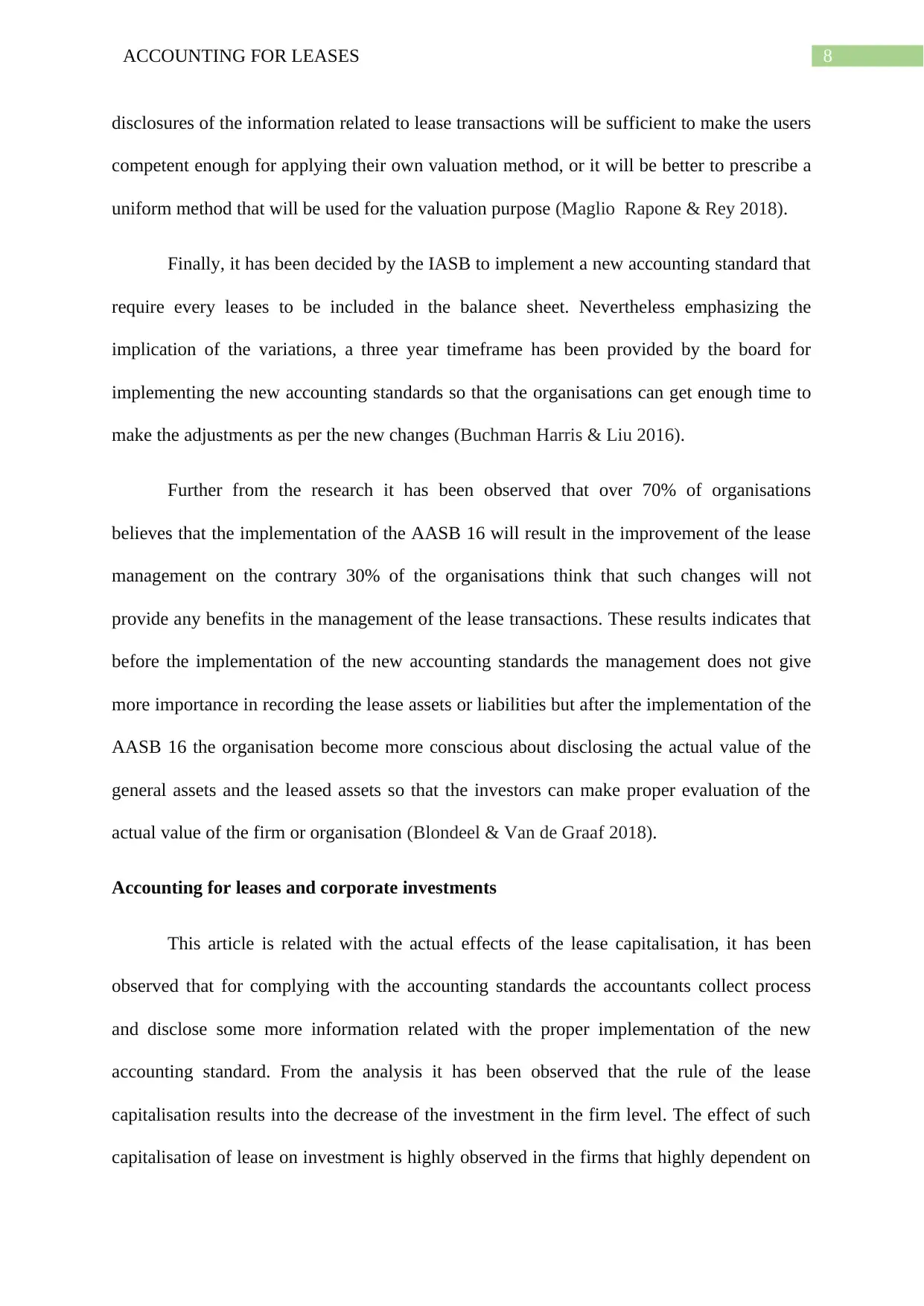
8ACCOUNTING FOR LEASES
disclosures of the information related to lease transactions will be sufficient to make the users
competent enough for applying their own valuation method, or it will be better to prescribe a
uniform method that will be used for the valuation purpose (Maglio Rapone & Rey 2018).
Finally, it has been decided by the IASB to implement a new accounting standard that
require every leases to be included in the balance sheet. Nevertheless emphasizing the
implication of the variations, a three year timeframe has been provided by the board for
implementing the new accounting standards so that the organisations can get enough time to
make the adjustments as per the new changes (Buchman Harris & Liu 2016).
Further from the research it has been observed that over 70% of organisations
believes that the implementation of the AASB 16 will result in the improvement of the lease
management on the contrary 30% of the organisations think that such changes will not
provide any benefits in the management of the lease transactions. These results indicates that
before the implementation of the new accounting standards the management does not give
more importance in recording the lease assets or liabilities but after the implementation of the
AASB 16 the organisation become more conscious about disclosing the actual value of the
general assets and the leased assets so that the investors can make proper evaluation of the
actual value of the firm or organisation (Blondeel & Van de Graaf 2018).
Accounting for leases and corporate investments
This article is related with the actual effects of the lease capitalisation, it has been
observed that for complying with the accounting standards the accountants collect process
and disclose some more information related with the proper implementation of the new
accounting standard. From the analysis it has been observed that the rule of the lease
capitalisation results into the decrease of the investment in the firm level. The effect of such
capitalisation of lease on investment is highly observed in the firms that highly dependent on
disclosures of the information related to lease transactions will be sufficient to make the users
competent enough for applying their own valuation method, or it will be better to prescribe a
uniform method that will be used for the valuation purpose (Maglio Rapone & Rey 2018).
Finally, it has been decided by the IASB to implement a new accounting standard that
require every leases to be included in the balance sheet. Nevertheless emphasizing the
implication of the variations, a three year timeframe has been provided by the board for
implementing the new accounting standards so that the organisations can get enough time to
make the adjustments as per the new changes (Buchman Harris & Liu 2016).
Further from the research it has been observed that over 70% of organisations
believes that the implementation of the AASB 16 will result in the improvement of the lease
management on the contrary 30% of the organisations think that such changes will not
provide any benefits in the management of the lease transactions. These results indicates that
before the implementation of the new accounting standards the management does not give
more importance in recording the lease assets or liabilities but after the implementation of the
AASB 16 the organisation become more conscious about disclosing the actual value of the
general assets and the leased assets so that the investors can make proper evaluation of the
actual value of the firm or organisation (Blondeel & Van de Graaf 2018).
Accounting for leases and corporate investments
This article is related with the actual effects of the lease capitalisation, it has been
observed that for complying with the accounting standards the accountants collect process
and disclose some more information related with the proper implementation of the new
accounting standard. From the analysis it has been observed that the rule of the lease
capitalisation results into the decrease of the investment in the firm level. The effect of such
capitalisation of lease on investment is highly observed in the firms that highly dependent on
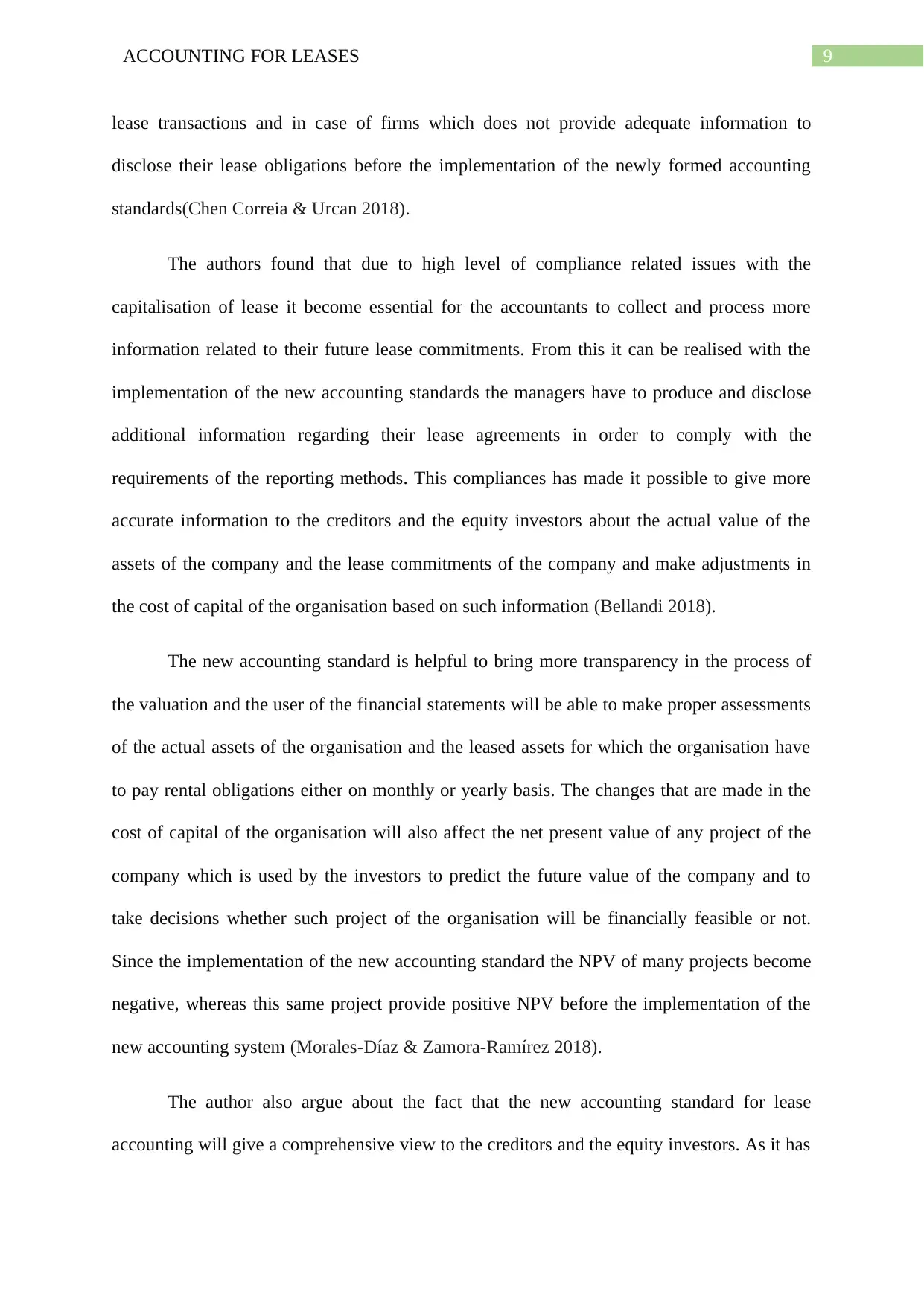
9ACCOUNTING FOR LEASES
lease transactions and in case of firms which does not provide adequate information to
disclose their lease obligations before the implementation of the newly formed accounting
standards(Chen Correia & Urcan 2018).
The authors found that due to high level of compliance related issues with the
capitalisation of lease it become essential for the accountants to collect and process more
information related to their future lease commitments. From this it can be realised with the
implementation of the new accounting standards the managers have to produce and disclose
additional information regarding their lease agreements in order to comply with the
requirements of the reporting methods. This compliances has made it possible to give more
accurate information to the creditors and the equity investors about the actual value of the
assets of the company and the lease commitments of the company and make adjustments in
the cost of capital of the organisation based on such information (Bellandi 2018).
The new accounting standard is helpful to bring more transparency in the process of
the valuation and the user of the financial statements will be able to make proper assessments
of the actual assets of the organisation and the leased assets for which the organisation have
to pay rental obligations either on monthly or yearly basis. The changes that are made in the
cost of capital of the organisation will also affect the net present value of any project of the
company which is used by the investors to predict the future value of the company and to
take decisions whether such project of the organisation will be financially feasible or not.
Since the implementation of the new accounting standard the NPV of many projects become
negative, whereas this same project provide positive NPV before the implementation of the
new accounting system (Morales-Díaz & Zamora-Ramírez 2018).
The author also argue about the fact that the new accounting standard for lease
accounting will give a comprehensive view to the creditors and the equity investors. As it has
lease transactions and in case of firms which does not provide adequate information to
disclose their lease obligations before the implementation of the newly formed accounting
standards(Chen Correia & Urcan 2018).
The authors found that due to high level of compliance related issues with the
capitalisation of lease it become essential for the accountants to collect and process more
information related to their future lease commitments. From this it can be realised with the
implementation of the new accounting standards the managers have to produce and disclose
additional information regarding their lease agreements in order to comply with the
requirements of the reporting methods. This compliances has made it possible to give more
accurate information to the creditors and the equity investors about the actual value of the
assets of the company and the lease commitments of the company and make adjustments in
the cost of capital of the organisation based on such information (Bellandi 2018).
The new accounting standard is helpful to bring more transparency in the process of
the valuation and the user of the financial statements will be able to make proper assessments
of the actual assets of the organisation and the leased assets for which the organisation have
to pay rental obligations either on monthly or yearly basis. The changes that are made in the
cost of capital of the organisation will also affect the net present value of any project of the
company which is used by the investors to predict the future value of the company and to
take decisions whether such project of the organisation will be financially feasible or not.
Since the implementation of the new accounting standard the NPV of many projects become
negative, whereas this same project provide positive NPV before the implementation of the
new accounting system (Morales-Díaz & Zamora-Ramírez 2018).
The author also argue about the fact that the new accounting standard for lease
accounting will give a comprehensive view to the creditors and the equity investors. As it has
Secure Best Marks with AI Grader
Need help grading? Try our AI Grader for instant feedback on your assignments.
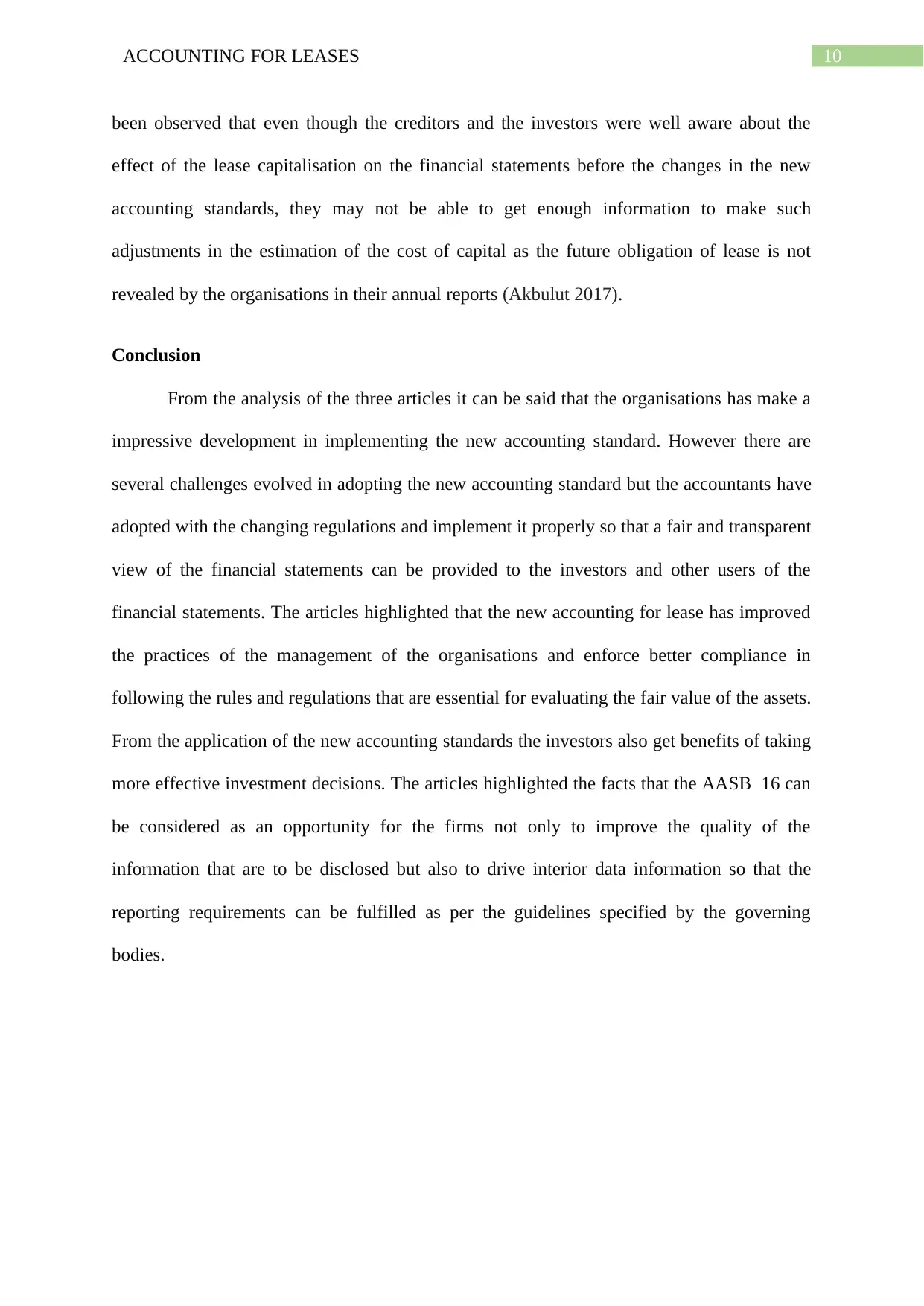
10ACCOUNTING FOR LEASES
been observed that even though the creditors and the investors were well aware about the
effect of the lease capitalisation on the financial statements before the changes in the new
accounting standards, they may not be able to get enough information to make such
adjustments in the estimation of the cost of capital as the future obligation of lease is not
revealed by the organisations in their annual reports (Akbulut 2017).
Conclusion
From the analysis of the three articles it can be said that the organisations has make a
impressive development in implementing the new accounting standard. However there are
several challenges evolved in adopting the new accounting standard but the accountants have
adopted with the changing regulations and implement it properly so that a fair and transparent
view of the financial statements can be provided to the investors and other users of the
financial statements. The articles highlighted that the new accounting for lease has improved
the practices of the management of the organisations and enforce better compliance in
following the rules and regulations that are essential for evaluating the fair value of the assets.
From the application of the new accounting standards the investors also get benefits of taking
more effective investment decisions. The articles highlighted the facts that the AASB 16 can
be considered as an opportunity for the firms not only to improve the quality of the
information that are to be disclosed but also to drive interior data information so that the
reporting requirements can be fulfilled as per the guidelines specified by the governing
bodies.
been observed that even though the creditors and the investors were well aware about the
effect of the lease capitalisation on the financial statements before the changes in the new
accounting standards, they may not be able to get enough information to make such
adjustments in the estimation of the cost of capital as the future obligation of lease is not
revealed by the organisations in their annual reports (Akbulut 2017).
Conclusion
From the analysis of the three articles it can be said that the organisations has make a
impressive development in implementing the new accounting standard. However there are
several challenges evolved in adopting the new accounting standard but the accountants have
adopted with the changing regulations and implement it properly so that a fair and transparent
view of the financial statements can be provided to the investors and other users of the
financial statements. The articles highlighted that the new accounting for lease has improved
the practices of the management of the organisations and enforce better compliance in
following the rules and regulations that are essential for evaluating the fair value of the assets.
From the application of the new accounting standards the investors also get benefits of taking
more effective investment decisions. The articles highlighted the facts that the AASB 16 can
be considered as an opportunity for the firms not only to improve the quality of the
information that are to be disclosed but also to drive interior data information so that the
reporting requirements can be fulfilled as per the guidelines specified by the governing
bodies.
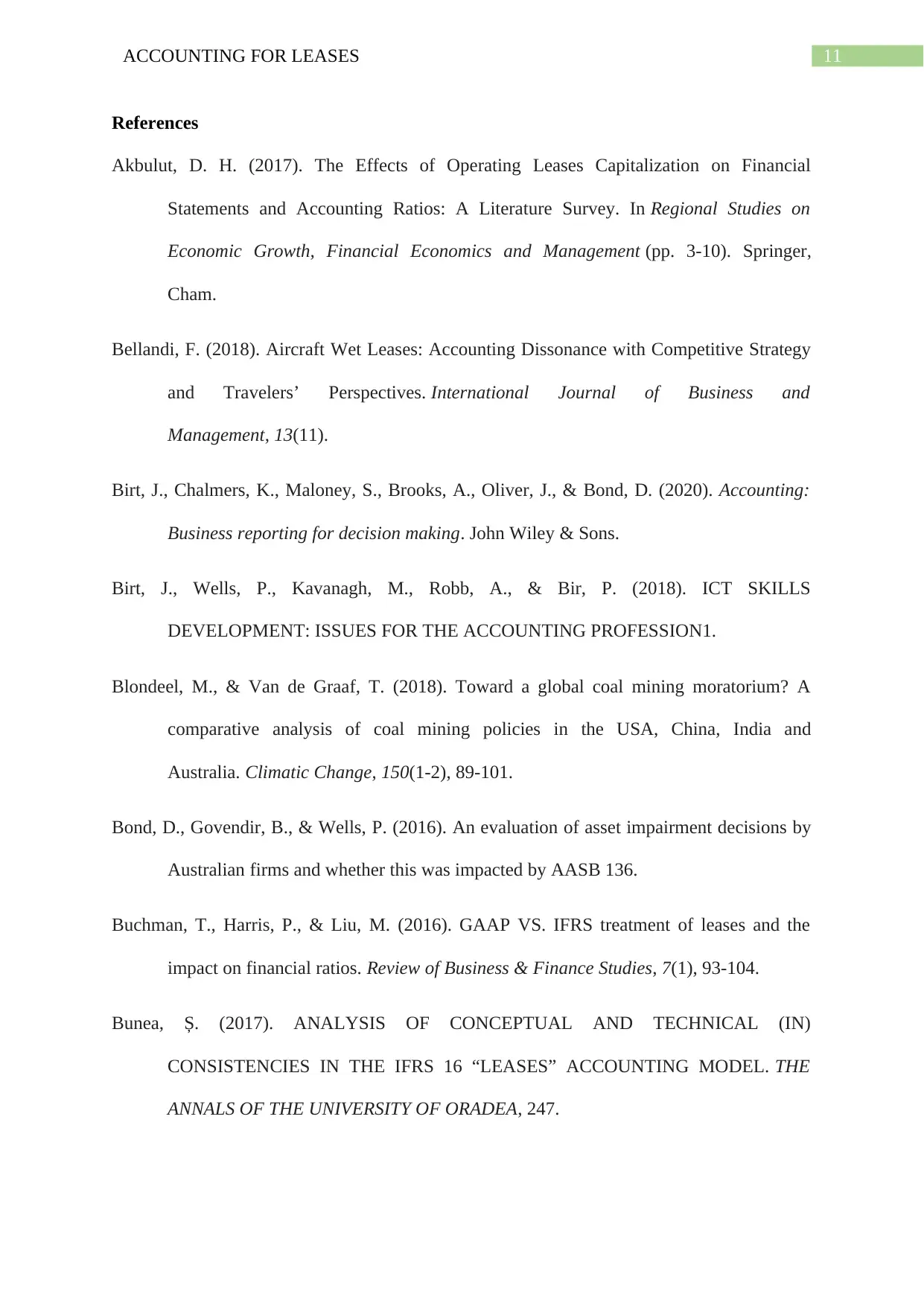
11ACCOUNTING FOR LEASES
References
Akbulut, D. H. (2017). The Effects of Operating Leases Capitalization on Financial
Statements and Accounting Ratios: A Literature Survey. In Regional Studies on
Economic Growth, Financial Economics and Management (pp. 3-10). Springer,
Cham.
Bellandi, F. (2018). Aircraft Wet Leases: Accounting Dissonance with Competitive Strategy
and Travelers’ Perspectives. International Journal of Business and
Management, 13(11).
Birt, J., Chalmers, K., Maloney, S., Brooks, A., Oliver, J., & Bond, D. (2020). Accounting:
Business reporting for decision making. John Wiley & Sons.
Birt, J., Wells, P., Kavanagh, M., Robb, A., & Bir, P. (2018). ICT SKILLS
DEVELOPMENT: ISSUES FOR THE ACCOUNTING PROFESSION1.
Blondeel, M., & Van de Graaf, T. (2018). Toward a global coal mining moratorium? A
comparative analysis of coal mining policies in the USA, China, India and
Australia. Climatic Change, 150(1-2), 89-101.
Bond, D., Govendir, B., & Wells, P. (2016). An evaluation of asset impairment decisions by
Australian firms and whether this was impacted by AASB 136.
Buchman, T., Harris, P., & Liu, M. (2016). GAAP VS. IFRS treatment of leases and the
impact on financial ratios. Review of Business & Finance Studies, 7(1), 93-104.
Bunea, Ș. (2017). ANALYSIS OF CONCEPTUAL AND TECHNICAL (IN)
CONSISTENCIES IN THE IFRS 16 “LEASES” ACCOUNTING MODEL. THE
ANNALS OF THE UNIVERSITY OF ORADEA, 247.
References
Akbulut, D. H. (2017). The Effects of Operating Leases Capitalization on Financial
Statements and Accounting Ratios: A Literature Survey. In Regional Studies on
Economic Growth, Financial Economics and Management (pp. 3-10). Springer,
Cham.
Bellandi, F. (2018). Aircraft Wet Leases: Accounting Dissonance with Competitive Strategy
and Travelers’ Perspectives. International Journal of Business and
Management, 13(11).
Birt, J., Chalmers, K., Maloney, S., Brooks, A., Oliver, J., & Bond, D. (2020). Accounting:
Business reporting for decision making. John Wiley & Sons.
Birt, J., Wells, P., Kavanagh, M., Robb, A., & Bir, P. (2018). ICT SKILLS
DEVELOPMENT: ISSUES FOR THE ACCOUNTING PROFESSION1.
Blondeel, M., & Van de Graaf, T. (2018). Toward a global coal mining moratorium? A
comparative analysis of coal mining policies in the USA, China, India and
Australia. Climatic Change, 150(1-2), 89-101.
Bond, D., Govendir, B., & Wells, P. (2016). An evaluation of asset impairment decisions by
Australian firms and whether this was impacted by AASB 136.
Buchman, T., Harris, P., & Liu, M. (2016). GAAP VS. IFRS treatment of leases and the
impact on financial ratios. Review of Business & Finance Studies, 7(1), 93-104.
Bunea, Ș. (2017). ANALYSIS OF CONCEPTUAL AND TECHNICAL (IN)
CONSISTENCIES IN THE IFRS 16 “LEASES” ACCOUNTING MODEL. THE
ANNALS OF THE UNIVERSITY OF ORADEA, 247.
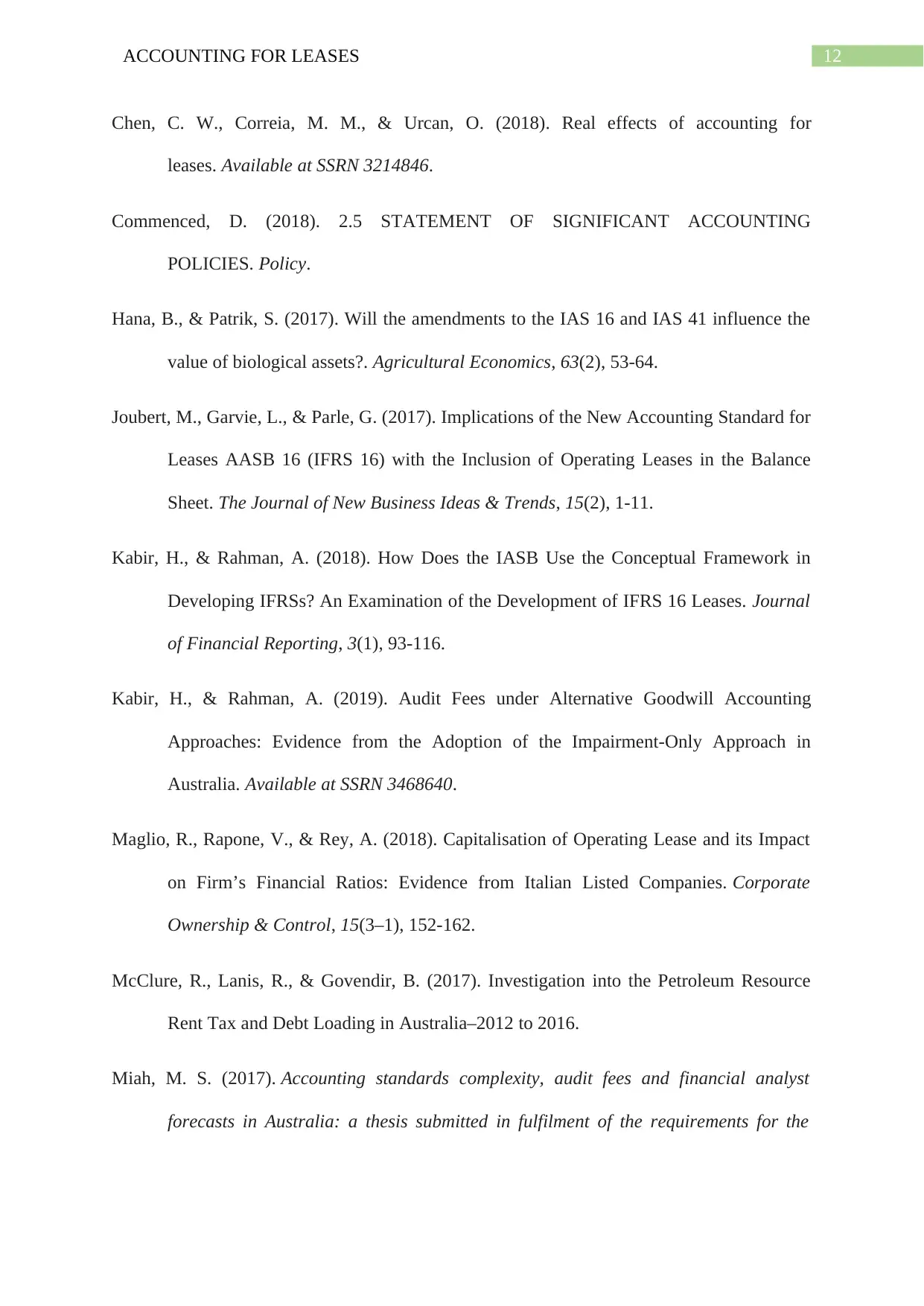
12ACCOUNTING FOR LEASES
Chen, C. W., Correia, M. M., & Urcan, O. (2018). Real effects of accounting for
leases. Available at SSRN 3214846.
Commenced, D. (2018). 2.5 STATEMENT OF SIGNIFICANT ACCOUNTING
POLICIES. Policy.
Hana, B., & Patrik, S. (2017). Will the amendments to the IAS 16 and IAS 41 influence the
value of biological assets?. Agricultural Economics, 63(2), 53-64.
Joubert, M., Garvie, L., & Parle, G. (2017). Implications of the New Accounting Standard for
Leases AASB 16 (IFRS 16) with the Inclusion of Operating Leases in the Balance
Sheet. The Journal of New Business Ideas & Trends, 15(2), 1-11.
Kabir, H., & Rahman, A. (2018). How Does the IASB Use the Conceptual Framework in
Developing IFRSs? An Examination of the Development of IFRS 16 Leases. Journal
of Financial Reporting, 3(1), 93-116.
Kabir, H., & Rahman, A. (2019). Audit Fees under Alternative Goodwill Accounting
Approaches: Evidence from the Adoption of the Impairment-Only Approach in
Australia. Available at SSRN 3468640.
Maglio, R., Rapone, V., & Rey, A. (2018). Capitalisation of Operating Lease and its Impact
on Firm’s Financial Ratios: Evidence from Italian Listed Companies. Corporate
Ownership & Control, 15(3–1), 152-162.
McClure, R., Lanis, R., & Govendir, B. (2017). Investigation into the Petroleum Resource
Rent Tax and Debt Loading in Australia–2012 to 2016.
Miah, M. S. (2017). Accounting standards complexity, audit fees and financial analyst
forecasts in Australia: a thesis submitted in fulfilment of the requirements for the
Chen, C. W., Correia, M. M., & Urcan, O. (2018). Real effects of accounting for
leases. Available at SSRN 3214846.
Commenced, D. (2018). 2.5 STATEMENT OF SIGNIFICANT ACCOUNTING
POLICIES. Policy.
Hana, B., & Patrik, S. (2017). Will the amendments to the IAS 16 and IAS 41 influence the
value of biological assets?. Agricultural Economics, 63(2), 53-64.
Joubert, M., Garvie, L., & Parle, G. (2017). Implications of the New Accounting Standard for
Leases AASB 16 (IFRS 16) with the Inclusion of Operating Leases in the Balance
Sheet. The Journal of New Business Ideas & Trends, 15(2), 1-11.
Kabir, H., & Rahman, A. (2018). How Does the IASB Use the Conceptual Framework in
Developing IFRSs? An Examination of the Development of IFRS 16 Leases. Journal
of Financial Reporting, 3(1), 93-116.
Kabir, H., & Rahman, A. (2019). Audit Fees under Alternative Goodwill Accounting
Approaches: Evidence from the Adoption of the Impairment-Only Approach in
Australia. Available at SSRN 3468640.
Maglio, R., Rapone, V., & Rey, A. (2018). Capitalisation of Operating Lease and its Impact
on Firm’s Financial Ratios: Evidence from Italian Listed Companies. Corporate
Ownership & Control, 15(3–1), 152-162.
McClure, R., Lanis, R., & Govendir, B. (2017). Investigation into the Petroleum Resource
Rent Tax and Debt Loading in Australia–2012 to 2016.
Miah, M. S. (2017). Accounting standards complexity, audit fees and financial analyst
forecasts in Australia: a thesis submitted in fulfilment of the requirements for the
Paraphrase This Document
Need a fresh take? Get an instant paraphrase of this document with our AI Paraphraser
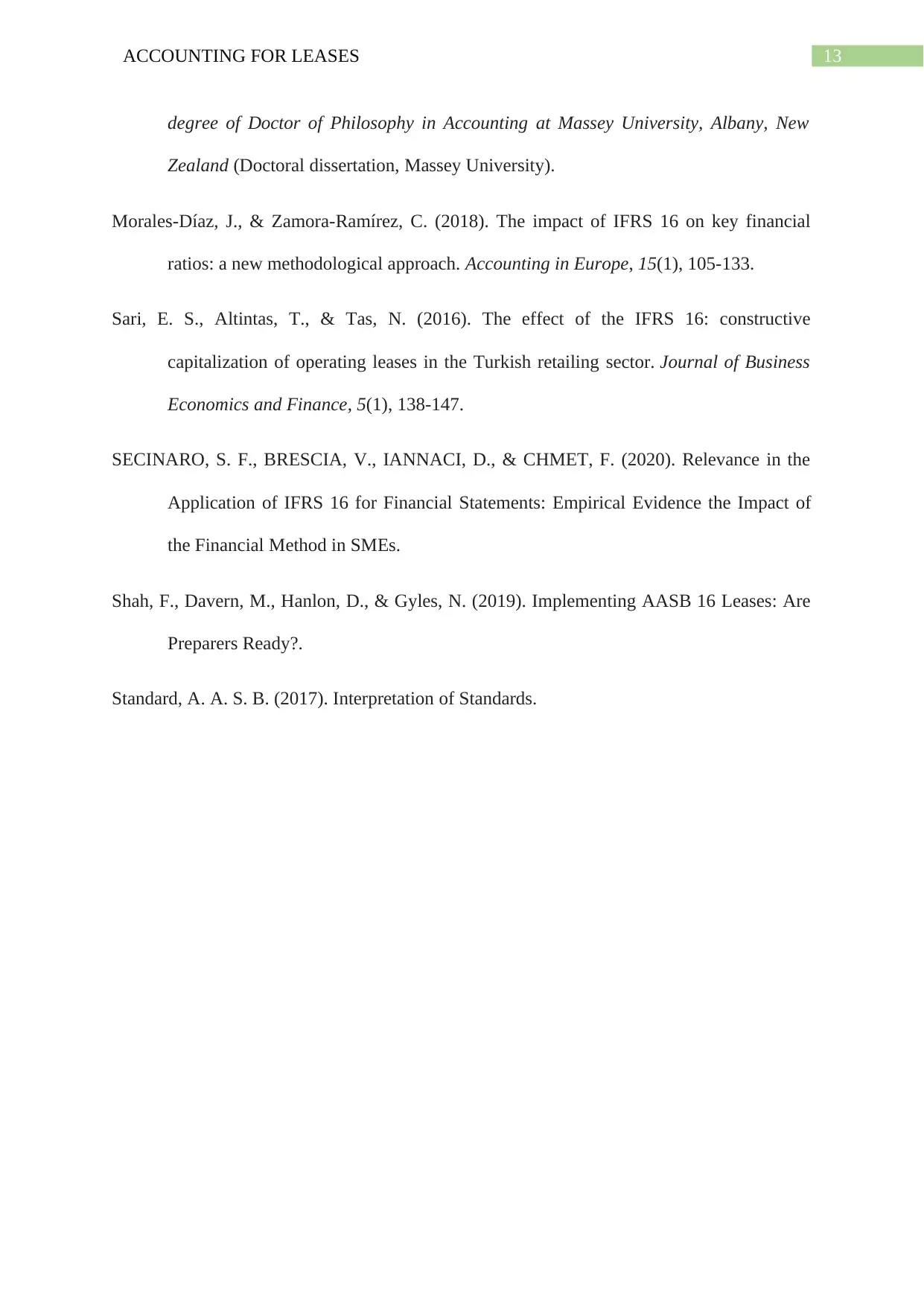
13ACCOUNTING FOR LEASES
degree of Doctor of Philosophy in Accounting at Massey University, Albany, New
Zealand (Doctoral dissertation, Massey University).
Morales-Díaz, J., & Zamora-Ramírez, C. (2018). The impact of IFRS 16 on key financial
ratios: a new methodological approach. Accounting in Europe, 15(1), 105-133.
Sari, E. S., Altintas, T., & Tas, N. (2016). The effect of the IFRS 16: constructive
capitalization of operating leases in the Turkish retailing sector. Journal of Business
Economics and Finance, 5(1), 138-147.
SECINARO, S. F., BRESCIA, V., IANNACI, D., & CHMET, F. (2020). Relevance in the
Application of IFRS 16 for Financial Statements: Empirical Evidence the Impact of
the Financial Method in SMEs.
Shah, F., Davern, M., Hanlon, D., & Gyles, N. (2019). Implementing AASB 16 Leases: Are
Preparers Ready?.
Standard, A. A. S. B. (2017). Interpretation of Standards.
degree of Doctor of Philosophy in Accounting at Massey University, Albany, New
Zealand (Doctoral dissertation, Massey University).
Morales-Díaz, J., & Zamora-Ramírez, C. (2018). The impact of IFRS 16 on key financial
ratios: a new methodological approach. Accounting in Europe, 15(1), 105-133.
Sari, E. S., Altintas, T., & Tas, N. (2016). The effect of the IFRS 16: constructive
capitalization of operating leases in the Turkish retailing sector. Journal of Business
Economics and Finance, 5(1), 138-147.
SECINARO, S. F., BRESCIA, V., IANNACI, D., & CHMET, F. (2020). Relevance in the
Application of IFRS 16 for Financial Statements: Empirical Evidence the Impact of
the Financial Method in SMEs.
Shah, F., Davern, M., Hanlon, D., & Gyles, N. (2019). Implementing AASB 16 Leases: Are
Preparers Ready?.
Standard, A. A. S. B. (2017). Interpretation of Standards.
1 out of 14
Related Documents
Your All-in-One AI-Powered Toolkit for Academic Success.
+13062052269
info@desklib.com
Available 24*7 on WhatsApp / Email
![[object Object]](/_next/static/media/star-bottom.7253800d.svg)
Unlock your academic potential
© 2024 | Zucol Services PVT LTD | All rights reserved.





